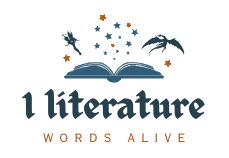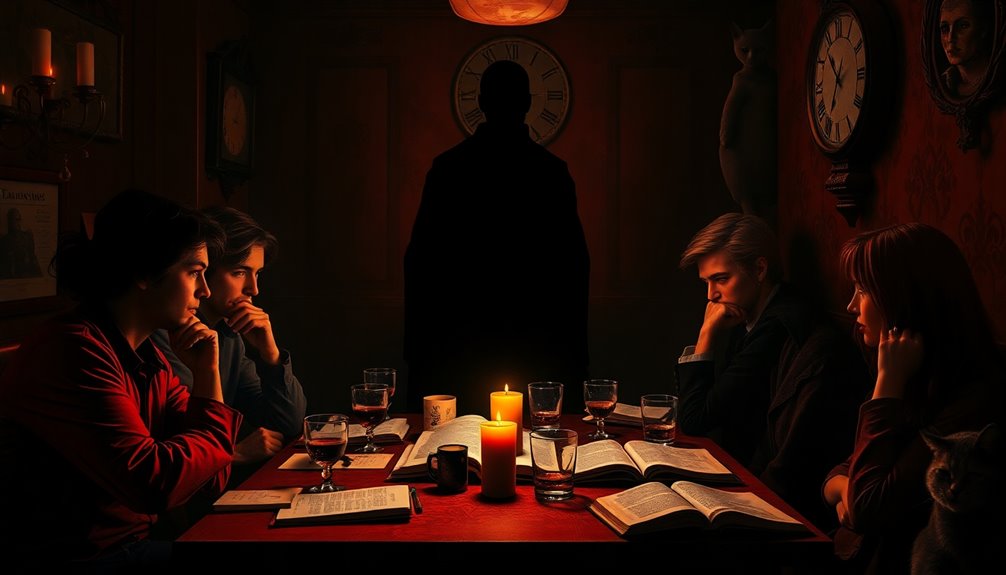If you're curious about Mikhail Bulgakov's "The Master and Margarita," you'll find it a surreal Soviet classic brimming with dark humor and powerful themes. The novel intertwines the stories of 1930s Moscow and ancient Jerusalem, challenging you to ponder good versus evil and moral dilemmas. Characters like Woland and Margarita shine, showcasing resilience amid oppression. Critics praise its unique blend of satire and magical realism, reflecting the absurdities of Soviet life. With a staggering rating of 4.29, it's clear that this tale resonates deeply. Stick around, and you'll uncover even more intriguing insights about this literary gem.
Overview of the Novel
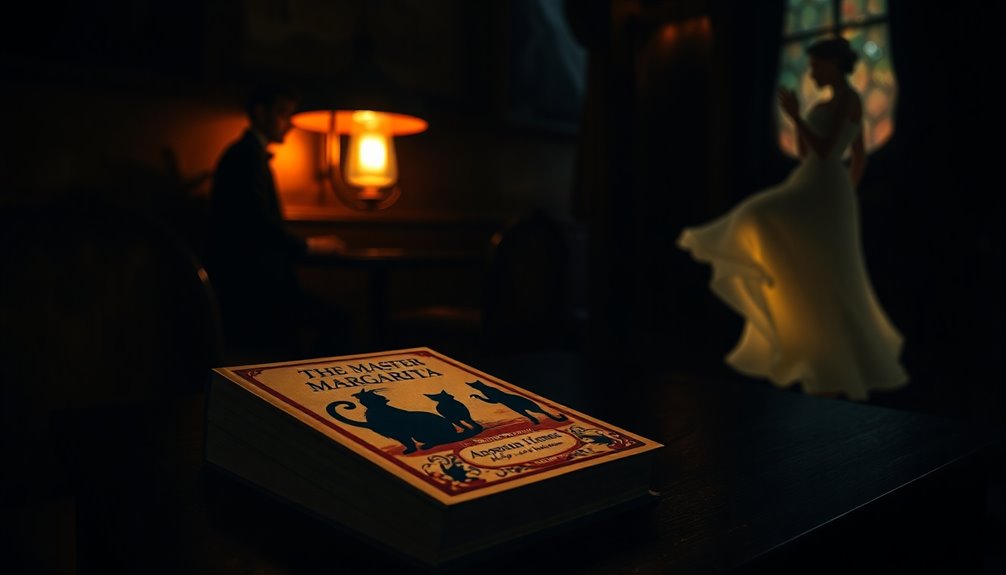
In "The Master and Margarita," Mikhail Bulgakov masterfully weaves together two compelling narratives: one set in 1930s Moscow, where the devil, Woland, stirs chaos, and the other in ancient Jerusalem, featuring the conflicted Pontius Pilate.
This novel serves as a bold exploration of good and evil, reflecting the moral ambiguities of life under the oppressive regime of the Soviet Union. Bulgakov's work also resonates with the themes of survival and resilience found in many non-fiction accounts, showcasing the human spirit's ability to endure amidst adversity. In the face of tyranny, characters like Margarita demonstrate remarkable acts of courage that emphasize the strength of the human spirit.
You'll encounter a rich cast of characters, including the tormented Master and his devoted lover, Margarita, whose passionate relationship symbolizes hope and resilience against the backdrop of censorship and repression.
Woland's antics in Moscow critique the absurdities of Soviet society, while Pilate's struggle with his conscience highlights the eternal conflict between duty and morality.
Bulgakov's unique blend of humor, surrealism, and profound commentary makes this work a staple of Russian magical realism.
The narrative's themes resonate deeply, emphasizing artistic integrity and the endurance of the human spirit.
Even though the novel faced censorship during Bulgakov's lifetime, its posthumous publication in the 1960s allowed readers to appreciate its timeless message: "manuscripts don't burn," signifying the power of art to transcend oppression. Additionally, the exploration of friendship and love in the narrative echoes the profound connections seen in works like "The Little Prince," highlighting the importance of meaningful relationships amidst chaos.
Author's Background
Understanding Mikhail Bulgakov's background helps you grasp the complexities in "The Master and Margarita." His early life in Kyiv and shift from medicine to writing shaped his unique perspective, while his struggles with censorship reveal the challenges he faced under the Soviet regime. After his death, the posthumous recognition of his work highlights the lasting impact of his literary contributions. Bulgakov's experiences with literary activism reflect the broader challenges faced by writers like Richard Wright, who also navigated oppressive societal norms. His work, much like that of E.L. James, showcases the power of storytelling in the face of adversity, emphasizing the importance of collective action in resisting oppression.
Early Life Influences
Born in Kyiv on May 3, 1891, Mikhail Bulgakov's early life set the stage for his profound literary contributions. Initially pursuing a career in medicine, he eventually turned to writing, influenced by the turbulent events around him. His experiences during World War I and the Russian Civil War deeply shaped his views on tyranny and the individual's struggle against oppressive forces, particularly the Soviet system.
Here are three key influences on Bulgakov's early life:
- Medical Background: His training in medicine provided him with a unique perspective on human nature, suffering, and morality.
- War Experiences: The chaos of war highlighted the brutality of authority, fueling his later critiques of Soviet oppression.
- Censorship: Facing ongoing anxiety about publication under Stalin's regime, he became acutely aware of the challenges artists faced in maintaining their artistic integrity.
These early experiences not only influenced Bulgakov's writing but also laid the groundwork for his enduring themes of resistance and the quest for truth amidst adversity, culminating in works like "The Master and Margarita."
Struggles With Censorship
Censorship posed a formidable challenge for Mikhail Bulgakov, shaping his career and creative output throughout the oppressive atmosphere of Stalin's regime. You can see how his struggle with censorship influenced not only his writing but also his very existence as an artist.
Bulgakov faced significant hurdles in getting his works published, as the regime tightly controlled literary expression. His manuscript for "The Master and Margarita" underwent multiple revisions, burnings, and resurrections, reflecting the relentless scrutiny he endured.
Despite these setbacks, Bulgakov held onto the belief that "manuscripts don't burn." This phrase encapsulates his conviction in the enduring power of art, even in the face of oppressive forces. His experiences with censorship mirrored the broader climate of fear and creative repression that many artists faced in the Soviet Union during this time.
Though he struggled to see his work recognized in his lifetime, the eventual posthumous publication of "The Master and Margarita" in the 1960s showcased the resilience of his creativity.
Ultimately, Bulgakov's battles with censorship reveal the complex relationship between an artist's life and the legacy they leave behind.
Posthumous Recognition Impact
Mikhail Bulgakov's posthumous recognition dramatically altered the landscape of Russian literature, transforming him from a struggling writer into a revered figure. His masterwork, "The Master and Margarita," wasn't published until 1966, years after his death, reflecting the harsh realities of censorship during Stalin's regime. This delay in recognition showcases the intricate dance between artistic integrity and a stifling political environment.
Here are three key impacts of his posthumous fame:
- Cultural Symbol: The novel became a symbol of resistance against totalitarianism, resonating strongly with readers yearning for freedom.
- Literary Canon: "The Master and Margarita" has earned its place as a cornerstone of Russian literature, acclaimed for its rich themes and complex characters.
- Enduring Popularity: With a rating of 4.29 based on over 378,000 ratings, its popularity underscores the lasting impact Bulgakov's work has on literature and culture.
Though he faced criticism during his lifetime, Bulgakov's posthumous recognition solidified his legacy, allowing his voice to echo through the corridors of literary history, where his struggles are now celebrated rather than suppressed.
Key Themes Explored
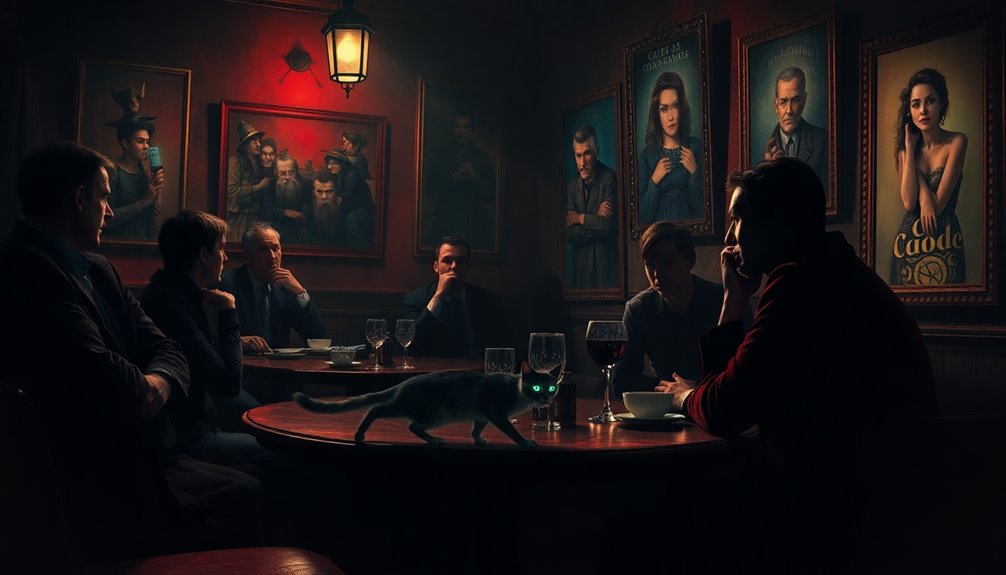
Amidst these serious themes, Bulgakov employs absurd humor and satire to critique the absurdities of Soviet life. You'll discover that the narrative captures the existential struggles faced by individuals under totalitarianism, all while maintaining a whimsical tone that makes the exploration of these themes deeply engaging. Additionally, the novel reflects on the impact of social media addiction on personal relationships, resonating with contemporary issues of isolation and connection. Furthermore, the characters embody remarkable resilience and strength, echoing the experiences of individuals who confront and overcome adversity, similar to the powerful narratives shared by women in survival stories. The exploration of hope and despair in the characters' journeys invites readers to reflect on their own resilience in the face of chaos.
Main Characters Overview
In "The Master and Margarita," Woland's chaotic influence challenges the status quo of Moscow society, pushing characters to confront their true selves. This confrontation mirrors the systemic racism faced by marginalized communities in Ta-Nehisi Coates' "Between the World and Me," illustrating how societal structures compel individuals to reckon with their identities. The complexities of marital dynamics within the narrative reflect the ongoing power struggles and negotiation of roles that are essential in understanding the characters' relationships.
Margarita's unwavering devotion and transformation into a witch showcase her strength as she fights to save the Master.
Meanwhile, Pontius Pilate grapples with his moral dilemmas, reflecting the novel's deeper themes of good and evil. The narrative also parallels the journey of courageous rebel fighters, as Margarita embodies bravery and resilience in her quest for love and justice.
Woland's Chaotic Influence
Woland's chaotic influence permeates "The Master and Margarita," revealing the cracks in 1930s Soviet society. As a devilish figure, he symbolizes the unpredictable forces challenging the moral fabric of this repressive regime. His arrival in Moscow catalyzes a series of surreal events, exposing the hypocrisy and cowardice of the elite.
You'll see how his interactions with characters like Ivan Bezdomny and Margarita highlight the complexities of good and evil.
Consider three key aspects of Woland's chaotic influence:
- Revealing True Nature: His presence forces characters to confront their authentic selves, stripping away societal masks.
- Moral Ambiguity: Through Woland, you'll grapple with the blurred lines between right and wrong, urging you to reflect on the nature of morality within an oppressive state.
- Artistic Integrity: Woland's chaos serves as a critique of the Soviet regime, emphasizing the importance of artistic freedom and the quest for redemption.
Through these elements, Bulgakov crafts a narrative rich in surrealism and social commentary, leaving you questioning the very essence of morality in a world turned upside down.
Margarita's Devotion and Transformation
Margarita's unwavering devotion to the Master reveals her strength and resilience in a world fraught with chaos and repression. As his devoted lover, she undergoes a profound transformation into a witch, showcasing her intelligence and determination. This metamorphosis isn't just about gaining magical powers; it's a demonstration of her fierce love and willingness to sacrifice everything to rescue him from despair.
When Margarita makes a pact with Woland, the devil, she embodies themes of love and sacrifice. Her journey highlights the struggle for artistic integrity against a backdrop of censorship and oppression, mirroring the Master's own battles. By embracing her newfound abilities, she reclaims her agency, defying societal constraints and confronting the oppressive forces that loom over Moscow.
Throughout the narrative, Margarita's unwavering loyalty emphasizes the power of personal connection amidst chaos and moral ambiguity. Her transformation isn't merely physical; it's a radical assertion of her will to fight for love and freedom, reflecting the depths of her character.
In a world that seeks to stifle creativity and passion, Margarita stands as a beacon of hope and resilience.
Pilate's Moral Dilemma
Five pivotal characters shape the narrative of *The Master and Margarita*, with Pontius Pilate standing out due to his profound moral dilemma. As the Roman governor, you see Pilate grappling with the weight of condemning Yeshua, which reflects the complex interplay of power and morality. His struggle showcases the challenge of acting justly amid political pressures and societal expectations.
- Pilate's conflict embodies the theme of good versus evil.
- His dialogue with Yeshua reveals deep philosophical questions about truth and faith.
- The haunting regret Pilate experiences emphasizes the consequences of his choices.
Ultimately, Pilate succumbs to the demands of the crowd, illustrating his cowardice and moral ambiguity. He questions, "What is truth?" but finds himself unable to embrace the higher moral truths Yeshua represents.
This internal conflict not only highlights Pilate's tragic flaw but also invites readers to reflect on their own beliefs about justice and integrity. Pilate's legacy in the narrative remains a poignant reminder of the enduring nature of moral dilemmas, compelling you to ponder the weight of personal conviction in the face of societal pressure.
Literary Style and Techniques
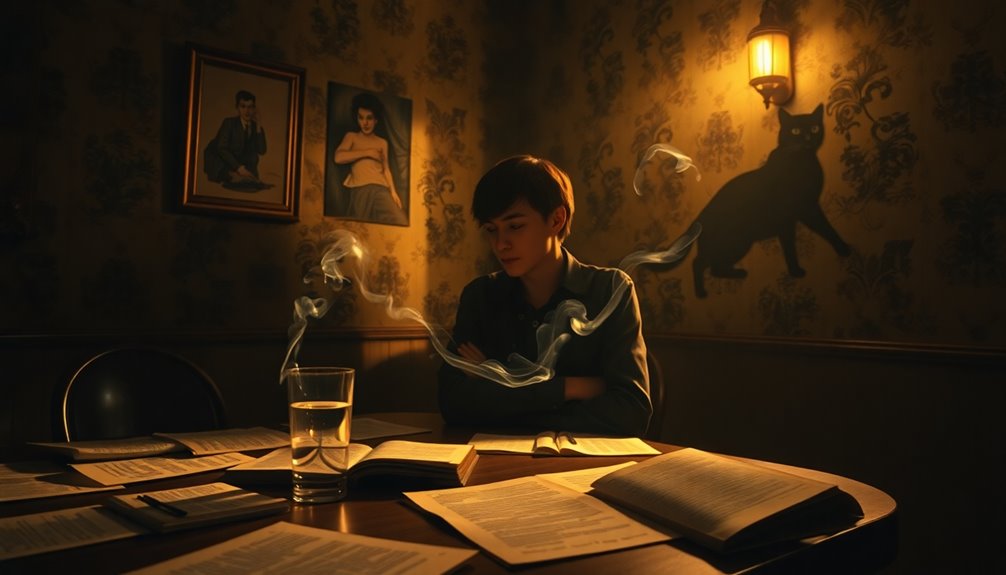
Employing rich imagery and symbolism, Mikhail Bulgakov's "The Master and Margarita" captivates readers with its intricate narrative style. You'll notice how he weaves together multiple storylines, contrasting the mundane life of 1930s Moscow with the timeless biblical tale of Pontius Pilate. This duality creates a fascinating tapestry that invites you to explore the deeper meanings behind each narrative thread. The exploration of memory and regret in literature can often parallel the complexities seen in Bulgakov's work.
Bulgakov's use of satire shines as he critiques societal norms and the literary establishment. You can't help but chuckle at the whimsical moments while feeling the weight of the serious themes lurking beneath the surface. His blend of surrealism and magical realism immerses you in an imaginative atmosphere that reflects the absurdity of life under a totalitarian regime, where totalitarian control often strips individuals of their freedoms.
The dialogue serves as an essential tool, revealing character motivations and relationships that add depth to the story. As you engage with the text, you'll appreciate how this combination of humor and philosophy resonates throughout, making "The Master and Margarita" not just a novel but a profound commentary on life itself. Additionally, Huxley's exploration of dystopian futures serves as an illuminating backdrop that enhances your understanding of Bulgakov's critique of oppressive systems.
Each page invites you to reflect on the absurdities that often mirror your own reality.
Reception and Critical Acclaim
How did "The Master and Margarita" become a cornerstone of 20th-century literature? This complex novel, published posthumously in the 1960s, garnered critical acclaim for its rich narrative and profound themes, striking a chord within the oppressive context of Soviet society.
Its unique blend of satire and magical realism captivated readers and critics alike, solidifying its status as a significant work of Russian literature.
Here are three reasons why it stands out:
- Innovative Narrative: Bulgakov weaves together multiple storylines, creating a tapestry of philosophical depth that engages with moral questions about good and evil.
- Cultural Resonance: The novel's themes resonate deeply with readers, reflecting the struggles of individuals under an oppressive regime, making it timeless and relatable.
- Enduring Influence: With a staggering rating of 4.29 from over 378,000 ratings, it continues to inspire adaptations, discussions, and scholarly analyses across generations.
Ultimately, "The Master and Margarita" not only exemplifies literary brilliance but also remains a powerful critique of society, ensuring its place in the pantheon of modern classics.
Cultural Impact and Legacy

"The Master and Margarita" has left an indelible mark on both literature and culture, shaping the way we think about artistic freedom and societal critique. Its influence on Russian literature is profound, as it boldly addresses the repressive nature of Soviet society through a unique blend of fantasy and satire.
The novel's famous phrase, "manuscripts don't burn," encapsulates the enduring power of artistic expression, symbolizing the struggle against censorship and oppression.
Since its posthumous publication in the 1960s, the novel has sparked a cult following, inspiring countless adaptations in theater, film, and music. Significantly, artists like the Rolling Stones have drawn upon its themes, further demonstrating its cultural impact.
The exploration of good versus evil and the nature of power resonates universally, allowing the book to transcend borders and engage readers across cultures.
Reader Experiences and Reviews
As you read "The Master and Margarita," you might find yourself forming a personal connection to its complex themes and characters.
Many readers report powerful emotional responses, especially regarding Margarita's unwavering love for the Master.
This shared experience often sparks vibrant community discussions, where everyone engages with the novel's rich layers of meaning.
Personal Connections to Text
What draws you to "The Master and Margarita"? You might find that its complex narrative resonates deeply with your own experiences.
Many readers forge personal connections with the themes of love, sacrifice, and artistic integrity, often reflecting on how these elements mirror their lives. Your reading experience isn't just about the story; it's about how the text shapes your thoughts and feelings long after you've closed the book.
Here are three ways you might connect with the novel:
- Nostalgic Moments: Specific quotes or scenes evoke memories, reminding you of your own struggles and triumphs.
- Community Engagement: Sharing insights with fellow readers enhances your understanding and appreciation of the text, fostering a sense of belonging.
- Revisiting the Text: Many express a desire to return to the novel during winter months, showing how its impact lingers and invites deeper exploration.
Each interaction with "The Master and Margarita" can lead to profound reflections, enriching your literary journey and personal growth.
Emotional Responses to Themes
Connecting deeply with the emotional themes in "The Master and Margarita" can lead you to profound insights about love, sacrifice, and the complexities of human morality. Many readers find themselves moved by Margarita's unwavering devotion to the Master, reflecting their own experiences of loyalty and the lengths one will go for love. This journey showcases the resilience of the human spirit, even in the face of overwhelming odds.
The novel's exploration of good versus evil, particularly through Woland's character, challenges you to confront moral ambiguity. You may wrestle with your beliefs about justice in an oppressive society, prompting introspection that feels incredibly relevant today.
Reviewers often highlight how Bulgakov balances humor with darker themes, providing a coping mechanism for maneuvering through despair and absurdity in life.
When you encounter the phrase "manuscripts don't burn," it resonates with hope and resilience, symbolizing art's enduring power against censorship. Pilate's moral conflict may evoke discussions about individual responsibility, making you reflect on the consequences of inaction in your own life.
Ultimately, these emotional responses enrich your reading experience, leaving you with lasting impressions on love, sacrifice, and morality.
Community Discussions and Engagement
In recent years, readers have flocked to "The Master and Margarita," sharing their unique experiences and insights that highlight the novel's profound impact on their lives.
This surge of community discussions showcases the emotional connection many feel towards Bulgakov's work, often leading to enlightening exchanges among both casual readers and the literary elite.
Here are three key themes often explored in these discussions:
- Art and Freedom: Many readers share personal anecdotes about how the novel reshaped their views on artistic expression and personal liberty, resonating deeply in today's sociopolitical climate.
- Humor and Tragedy: The blend of humor and tragedy serves as a coping mechanism for readers facing life's absurdities, creating a shared understanding that sparks lively debates.
- Cultural Relevance: Numerous reviewers emphasize the book's ongoing relevance, urging others to engage with the original Russian text to fully appreciate its nuances.
As more people connect through social media and organized group readings, "The Master and Margarita" continues to inspire rich discussions and foster a vibrant community of passionate readers.
Symbolism and Imagery

Through its rich tapestry of symbolism and imagery, "The Master and Margarita" explores deep into the complexities of human experience and societal critique. The phrase "manuscripts don't burn" powerfully symbolizes the enduring nature of art, suggesting that true creativity can survive even the harshest censorship.
As you navigate Margarita's journey, the recurring yellow flowers symbolize both love and the transformative power of passion, emphasizing her determination to reunite with the Master.
Woland's retinue, featuring characters like Behemoth and Koroviev, embodies various societal roles, using surreal imagery to critique the absurdities of Soviet life. You'll notice the striking juxtaposition between the mundane realities of 1930s Moscow and the ethereal elements of biblical Jerusalem, highlighting contrasts between good and evil, freedom and oppression.
Pontius Pilate's character introduces a profound sense of moral ambiguity, using symbolic imagery to explore themes of cowardice and the struggle between personal ethics and societal expectations.
This intricate web of symbolism and imagery enhances your understanding of the characters' motivations and the broader societal critiques, making the narrative resonate on multiple levels.
Comparisons to Other Works
Several literary works resonate with the themes and structure found in "The Master and Margarita." For instance, Goethe's "Faust" explores the devil's dealings with humanity, mirroring the temptations and moral dilemmas faced by Bulgakov's characters.
You can also see parallels with other notable works that enhance your understanding of Bulgakov's novel:
- Kafka's Absurdity: Like Kafka's narratives, Bulgakov employs surrealism and absurdity to critique societal norms and the oppressive nature of totalitarianism.
- García Márquez's Duality: The dual narrative structure in "The Master and Margarita" is reminiscent of Márquez's "One Hundred Years of Solitude," intertwining multiple timelines and realities to deepen the themes of the novel.
- Chekhov's Humor: The blend of humor and tragedy in Bulgakov's work aligns closely with the style of Anton Chekhov, who utilized wit to address serious social issues.
Furthermore, the romantic and tragic relationship between the Master and Margarita echoes the love and sacrifice found in Shakespeare's "Romeo and Juliet," highlighting the theme of redemption amidst chaos.
These comparisons enrich your appreciation of Bulgakov's profound and multifaceted narrative.
Conclusion
In "The Master and Margarita," you're swept into a whirlwind of magic and madness, where reality blurs like ink on wet paper. Bulgakov's masterful brush strokes paint a vivid tapestry of love, power, and redemption, leaving you breathless. As you close the final page, the echoes of its themes resonate like a haunting melody, inviting you to dive back into its depths. This surreal masterpiece doesn't just linger; it dances in your mind, forever enchanting your spirit.
